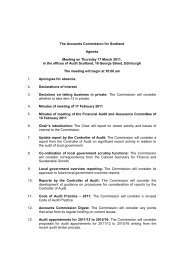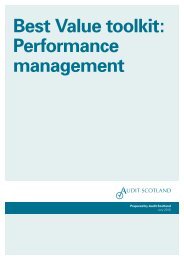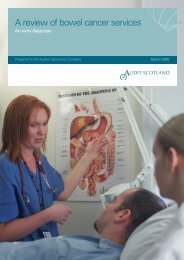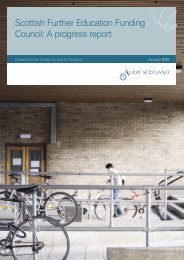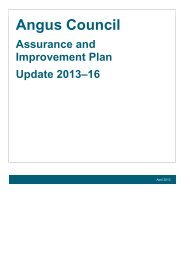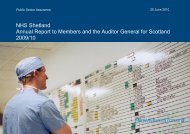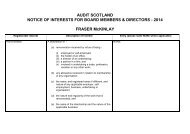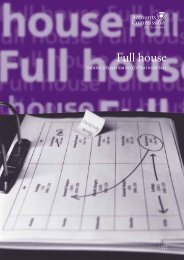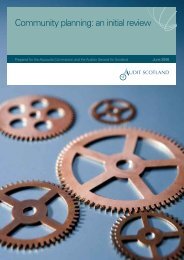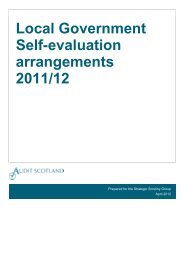Edinburgh transport projects review (PDF | 303 KB) - Audit Scotland
Edinburgh transport projects review (PDF | 303 KB) - Audit Scotland
Edinburgh transport projects review (PDF | 303 KB) - Audit Scotland
- No tags were found...
Create successful ePaper yourself
Turn your PDF publications into a flip-book with our unique Google optimized e-Paper software.
<strong>Edinburgh</strong><strong>transport</strong><strong>projects</strong> <strong>review</strong>Prepared for the <strong>Audit</strong>or General for <strong>Scotland</strong>June 2007
ContentsSummary 2Purpose of the report 2Aims and objectives of the <strong>review</strong> 2Our <strong>review</strong> 2Key messages 3Part 1. Introduction 6Both <strong>projects</strong> have been throughthe Parliamentary approval process 6Both <strong>projects</strong> have been developedin response to national, regionaland local <strong>transport</strong> strategies 6There are three key players for both<strong>projects</strong> 6High-level governancearrangements are satisfactory 7Part 2. <strong>Edinburgh</strong> trams 10Background to the project 10The cost and time targets for the<strong>Edinburgh</strong> trams project have beendeveloped using robust systems 12Arrangements in place to managethe project appear sound 14Part 3. <strong>Edinburgh</strong> AirportRail Link (EARL) 19Background to the project 19Due to the early stage of the EARLproject the estimated cost and timetargets remain uncertain 20Some arrangements in place tomanage the project appear soundbut others need to be improved 241
SummaryPurpose of the report1. On 4 June 2007, the Cabinet Secretary for Finance and Sustainable Growth asked the <strong>Audit</strong>orGeneral for <strong>Scotland</strong> to carry out a high-level <strong>review</strong> of the arrangements in place for estimating thecosts and managing the <strong>Edinburgh</strong> trams and <strong>Edinburgh</strong> Airport Rail Link (EARL) <strong>projects</strong>. The<strong>Audit</strong>or General had already made a commitment that <strong>Audit</strong> <strong>Scotland</strong> would undertake a <strong>review</strong> ofmajor capital <strong>projects</strong> in <strong>Scotland</strong> in its current work programme. On this basis, the <strong>Audit</strong>or Generalagreed to bring forward a more focused <strong>review</strong> of <strong>Edinburgh</strong> trams and EARL as part of the plannedwork. This report sets out the <strong>Audit</strong>or General’s findings.Aims and objectives of the <strong>review</strong>2. The high level objectives of this <strong>review</strong> were to assess:• Whether the <strong>Edinburgh</strong> trams and EARL <strong>projects</strong> are progressing in relation to time and costtargets.• Whether appropriate management systems are in place to promote successful completion of the<strong>Edinburgh</strong> trams and EARL <strong>projects</strong>.3. We have considered these objectives for each of the <strong>projects</strong> separately and the report is structuredaccordingly. Part 1 of the report pulls together common themes from each of the <strong>projects</strong>; Part 2comments on <strong>Edinburgh</strong> Trams; and Part 3 comments on the EARL project.Our <strong>review</strong>4. The <strong>review</strong> examined the process for estimating project costs and project managementarrangements for the two <strong>projects</strong>. It does not provide assurances on the accuracy of the estimatedproject costs. It is important to emphasise that we have not <strong>review</strong>ed the operating costs or projectedrevenues of the <strong>projects</strong>. Both of these factors could have a significant impact on the financialoperation of both <strong>projects</strong>. Nor have we <strong>review</strong>ed the options appraisals for the <strong>projects</strong> or thebenefits they are expected to generate.2
5. In undertaking this <strong>review</strong>, we took account of the earlier work that we carried out for ourperformance overview of <strong>transport</strong> in <strong>Scotland</strong> published in September 2006 and our regularmonitoring of the progress of major <strong>transport</strong> <strong>projects</strong>. 1 We also carried out interviews with seniorofficials from Transport <strong>Scotland</strong>, the City of <strong>Edinburgh</strong> Council (CEC) and <strong>transport</strong> initiativesedinburgh limited (tie) and <strong>review</strong>ed supporting documents for each of the <strong>projects</strong>.6. In preparing this report, we have shown our findings to all of the key players -Transport <strong>Scotland</strong>,CEC and tie - and taken their comments into account but due to our timescale we have not followedour usual formal clearance process.Key messages7. Both <strong>projects</strong> have been through the Parliamentary approval process to obtain statutory authority toproceed and have been developed in response to national, regional and local <strong>transport</strong> strategies.8. There are three key players common to both <strong>projects</strong> – Transport <strong>Scotland</strong>, CEC and tie - all ofwhich have satisfactory high-level governance arrangements in place.<strong>Edinburgh</strong> trams9. The <strong>Edinburgh</strong> trams project is intended to support and promote a growing local economy and createa healthy, safe and sustainable environment. The project is being taken forward in phases. Phase 1,the subject of this report, consists of a tram line connecting Leith Waterfront to <strong>Edinburgh</strong> Airport(Phase 1a) and a section from Roseburn to Granton Square (Phase 1b).10. The current anticipated final cost of Phase 1 in its entirety is £593.8 million and estimated projectcosts have been subjected to robust testing.11. The Scottish Executive has committed to provide up to £500 million for Phase 1a of the project andCEC a further £45 million. Funding for Phase 1b has yet to be confirmed.12. A total of £79 million was spent on the project up to the end of May 2007, which includes £17 millionto take the two Bills through the Parliamentary process.13. Some slippage in the project has occurred but tie is taking action to ensure that Phase 1a can beoperational by early 2011.1Scottish Executive: an overview of the performance of <strong>transport</strong> in <strong>Scotland</strong>, <strong>Audit</strong> <strong>Scotland</strong> (September 2006)3
time, individual project governance arrangements were updated in 2006. The current arrangementsare set out in Parts 2 and 3.36. tie’s executive team has also been re-organised with an Human Resources director and ChiefEngineer being added to the team. There are currently Project Directors for both <strong>Edinburgh</strong> tramsand EARL. The individuals holding these posts have changed over time to ensure that the necessaryskills and experiences required are in place for each stage of the project. tie is currently mid-waythrough a recruitment exercise for both posts. Recruiting new Project Directors at this stage carriesrisks, as continuity is important. However, tie believes the skills and experience necessary forcarrying the <strong>projects</strong> through their next stages to completion are different from those required for theearlier stages of gaining Parliamentary approval.37. There is evidence of regular and effective <strong>review</strong>s of progress within tie with the ExecutiveChairman, non-executive directors and senior staff playing a very active role in overseeing <strong>projects</strong>.38. tie operates financial management through a clear scheme of delegated authority to incurexpenditure. The tie board considers expenditure against budget at each meeting.9
Part 2. <strong>Edinburgh</strong> tramsBackground to the project39. tie was established to conduct investigations into how best to deliver CEC’s local <strong>transport</strong> strategy,including the desirability of building one or more tram lines in <strong>Edinburgh</strong>. In September 2002, tiesubmitted its proposals to CEC, identifying three trams lines as the most promising in terms ofeconomic viability and benefits to the city:• A northern loop connecting Granton and Leith to the city centre• A western line connecting the city centre to <strong>Edinburgh</strong> Airport• A south-eastern line connecting the city centre to the new Royal Infirmary.40. In March 2003, following CEC’s decision to take these lines forward, the Scottish Executiveannounced its support for the construction of the northern loop and western line (Exhibit 1). InJanuary 2004, two Bills were submitted to the Scottish Parliament which received Royal Assent inspring 2006.Exhibit 1: Proposed route of the <strong>Edinburgh</strong> trams projectNote: While legislative approval has been obtained for all three phases of the project, a phased construction approach means thatonly Phase 1 is being progressed at the moment.Source: Trams for <strong>Edinburgh</strong> website10
41. As the tram Bills were being considered in the Scottish Parliament, tie’s <strong>review</strong> of costs indicatedthat a complete network of both lines was unlikely to be affordable in one phase of construction. Thekey players involved concluded that the project should be taken forward in stages. Phase 1 of theproject, the subject of this report, consists of a line connecting Leith Waterfront to <strong>Edinburgh</strong> Airportvia Haymarket and Princes Street (Phase 1a) and a section from Roseburn to Granton Square(Phase 1b).The <strong>Edinburgh</strong> trams project is intended to support and promote agrowing local economy and create a healthy, safe and sustainableenvironment42. The project’s objectives are to:• support the local economy by improving accessibility• promote sustainability and reduce environmental damage caused by traffic• reduce traffic congestion• make the <strong>transport</strong> system safer and more secure• promote social benefits.43. A consultant’s appraisal of the project, using the Scottish Executive’s appraisal guidance, inNovember 2006 indicated that Phase 1 in its entirety was expected to deliver benefits of £1.63 per£1 of cost. 4 Phase 1a is expected to generate benefits of £1.10 per £1 of cost. Phase 1b is expectedto generate higher benefits because it is expected to contribute to the regeneration of Granton. Otheroutcomes expected from Phase 1 include:• more than 40,000 m 2 of factory, office and retail space by 2011 increasing to 114,000 m 2 by 2015(through regeneration)• 900 additional homes by 2011 rising to 5,250 by 2015 (through regeneration)• 930 additional jobs of which 590 are attributed to Phase 1a (through a mixture of construction andregeneration)• improved air quality, traffic noise and CO 2 emissions resulting from the transfer of car trips topublic <strong>transport</strong>4STAG 2 Appraisal, <strong>Edinburgh</strong> Tram Network, steer davies gleave, November 200611
• enhanced opportunities to make journeys on the public <strong>transport</strong> network through bus-tramservice integration and ticketing arrangements• improved access to key trip attractions and destinations.The cost and time targets for the <strong>Edinburgh</strong> trams project havebeen developed using robust systemsThe current anticipated final cost of Phase 1 is £593.8 million44. In January 2004, the total estimated cost of the northern loop and the western line, including thephases not currently being developed, was £473.5 million at March 2003 prices. This estimate didnot therefore take account of inflation and assumptions regarding the profile of expenditure overtime. Since then, costs have been reassessed at regular intervals as the project progressed.45. In January 2006, tie estimated the cost of Phase 1 as £435 million at March 2003 prices and£570 million in projected outturn prices, which included £135 million to take account of inflation andassumed expenditure profiles. By November 2006, cost had risen by about four per cent comparedto January 2006 to £592 million in projected outturn prices to reflect extensions to the scope due tothe project design being developed further. 5 The current anticipated final cost of Phase 1a is£501.8 million at projected outturn prices. For Phase 1b, the current anticipated final cost is£92 million at projected outturn prices.The Scottish Executive has committed to provide up to£500 million for the project and CEC a further £45 million46. In March 2003, the Scottish Executive indicated its willingness to provide £375 million for the project.In March 2006, Ministers announced that this funding would be updated for inflation and that theExecutive expected to provide between £450-£500 million for Phase 1a. CEC has also committed£45 million to the project.47. There is, therefore, sufficient funding in place to proceed with Phase 1a (£545 million againstestimated costs of £501.8 million) but a current shortfall of £48.8 million for Phase 1 in its entirety.Transport <strong>Scotland</strong> has not confirmed funding for Phase 1b. It expects that every effort will be madeto generate savings from Phase 1a and to maximise contributions from private sector developers.5<strong>Edinburgh</strong> Tram Network, Draft Final Business Case, tie, November 200612
£79 million was spent on the project up to the end of May 2007and a further £60 million funding has been provided for 2007/0848. A total of £17 million was spent taking the two tram Bills through the Parliamentary process. Thesecosts are not counted against the project’s overall anticipated final cost of £593.8 million. tie spent afurther £62 million up to the end of May 2007 implementing the project, including design work andother project management activities, legal fees and communications. These costs have been fundedby grant support from Transport <strong>Scotland</strong>.49. Transport <strong>Scotland</strong> has awarded a grant of £60 million for 2007/08 for utilities diversions, advanceworks and continuing development and procurement.The project cost estimates have been subject to robust testing50. In order to confirm its project cost estimates tie has subjected them to independent <strong>review</strong> byconsultants and benchmarked them against other UK tram <strong>projects</strong>. 6 For example, inNovember 2006, it compared its estimates for infrastructure construction (a significant element of thetotal project cost) with those of a recently completed tram system and found there was an overalldifference of less than three per cent in directly comparable items. tie’s project estimates will besubjected to further development and <strong>review</strong> before the final business case is presented to CEC andCabinet Secretaries for approval in January 2008.51. tie’s confidence in its cost estimates has grown as the project has progressed and bids frompotential contractors have been received. Following receipt of initial bids for infrastructureconstruction in January 2007, 79 per cent of the project estimate is now based on rates and pricesfrom firm bids received or on known rates applied to estimated quantities, for example utilitiesdiversion work. A further 20 per cent is based on market rates applied to quantities derived frompreliminary designs, for example the cost of land acquisition.52. The initial bids for infrastructure construction are subject to negotiation and tie intends to select thepreferred bidder in September 2007. tie has developed a negotiation strategy which it intends to useto reduce bids including savings arising from changes to design and specifications (commonly knownas value engineering savings). These negotiations have begun to generate significant valueengineering savings and tie is confident that Phase 1a can be delivered to the current anticipatedfinal cost of £501.8 million.6<strong>Edinburgh</strong> Tram Capital Cost Review Lines 1a & 1b, Brian Hannaby & Associates, November 200613
Some slippage in the project has occurred but action is beingtaken to ensure that Phase 1a can be operational by early 201153. At the time of submitting the Bills to Parliament in January 2004, the timescales for delivery of theproject could not be fixed due to uncertainty about the time to obtain Parliamentary approval.Indicative dates for construction were expected to be from mid-2006 to mid-2009, with a margin ofuncertainty of minus six months to plus 12 months.54. These timescales have been amended as the project has progressed. tie’s draft final business casein November 2006 indicated an operational start date for Phase 1a of December 2010 and forPhase 1b of December 2011. Since then, the estimated dates to sign contracts for infrastructureconstruction and vehicle delivery have slipped by four months to January 2008, to allow sufficienttime for negotiations. tie has responded to this delay by bringing forward advance works, includingcritical path works such as the construction of the tram depot at Gogar, and now expects Phase 1ato be operational on 21 January 2011.55. tie’s strategy to deliver the programme on target is to maintain sufficient time between utilitiesdiversion work and infrastructure work. Infrastructure construction bidders provided their own draftwork programmes to tie in May 2007 and tie is currently analysing these. The full extent ofcontingency within the programme will be confirmed once the bidder programme is negotiated andagreed.Arrangements in place to manage the project appear soundThere is a clear corporate governance structure for the projectwhich involves all key stakeholders56. The Tram Project Board exercises overall governance of the project. It includes seniorrepresentatives from tie, Transport <strong>Scotland</strong>, CEC and Transport <strong>Edinburgh</strong> Limited (TEL) and hasfull delegated authority from CEC (through TEL) and Transport <strong>Scotland</strong> to take the actions neededto deliver the project to agreed cost, timescale and quality standards (Exhibit 2). 7 The Tram ProjectBoard has a clear written remit, meets every four weeks to consider reports from tie’s Tram ProjectDirector and is supported by two sub-committees with responsibility for assessing progress with theprogramme.7Transport <strong>Edinburgh</strong> Limited (TEL) is an arm’s length company owned by CEC with responsibility for integrating bus and tramservices in <strong>Edinburgh</strong>. It is intended that once the <strong>Edinburgh</strong> tram system is introduced, TEL will operate Lothian Buses and thetram system on behalf of CEC.14
Exhibit 2. Tram Project Board governance structureCity of <strong>Edinburgh</strong> CouncilDirector of City DevelopmentTransport <strong>Scotland</strong>Director of Rail DeliverytieExecutive ChairTransport <strong>Edinburgh</strong> LtdChairChief ExecutiveTram Project BoardChaired by TEL chairSub-CommitteeBusiness planning,integration andcommercialsSub-CommitteeDesign, procurement anddeliveryTEL TeamPlanning, integration andcommercialTram ProjectDirectorand teamSource: tieProject management and organisation is clearly defined57. Day-to-day responsibility for delivering the project rests with the Tram Project Director who issupported by five teams responsible for delivery and programme, engineering matters, procurement,finance and operations and maintenance. The Tram Project Director exercises project controlthrough four-weekly <strong>review</strong>s of progress with project managers.58. There is a clear project programme that provides start and finish dates for each stage of work. Thereare also clearly documented project change control procedures in place. The Project Director andTram Project Board regularly <strong>review</strong> progress against the programme and consider requests tochange it.59. In September 2006, a Scottish Executive Gateway Review assessment of the project wasundertaken to test tie’s overall organisation and control over the project. The assessment found that15
there was a common understanding within tie of the requirements of the project and the challengesfaced, and that the majority of recommendations from an earlier readiness <strong>review</strong> had been fullyimplemented. A further Gateway <strong>review</strong> is planned before the submission of tie’s final business caseto CEC and Cabinet Secretaries.Financial management and reporting of the project appears sound60. tie operates financial control over the project through a clear scheme of delegated authority to incurexpenditure. The Tram Project Board considers expenditure against budget at each meeting andalso considers the financial consequences of requests to change the project programme.Procedures are in place to actively manage risk associated withthe project61. tie has developed a risk management plan setting out its requirements for recording, monitoring andreporting risks associated with the project. All project managers, functional managers andworkstream managers are responsible for identifying and assessing risk within their areas ofresponsibility. Risk is considered at the four-weekly meetings with the Tram Project Director andupdates to the primary risk register are considered at each Tram Project Board meeting.62. Quantitative allowances for risk and contingencies have also been built into the project cost estimateusing assessments of the likelihood of each risk occurring and its financial cost. As the project hasprogressed and risks have either dropped off or action to mitigate them has been taken, theallowance for risk and contingencies has reduced. In January 2006, tie’s project cost estimatecontained an allowance of 24 per cent for project risk and contingencies. In January 2007, a report tothe Tram Project Board stated that the allowance for risk and contingencies formed 10 per cent ofthe current project cost estimate, reflecting progress in procurement and risk management in theinterim period. The highest cost risks are currently utilities diversion work (where the volume of workis uncertain until digging starts) and general delay with the programme, for example failing to achieveTraffic Regulation Orders on time.A procurement strategy has been designed to minimise risk andlead to successful delivery of the project63. It is good practice to prepare a procurement strategy at the outset of a project to help determine howthe project can best be procured. This requires analysis of the risks facing the project, the fundingoptions and consideration of how different procurement routes can best meet the project objectivesincluding value for money.16
64. tie has developed a procurement strategy which is intended to enhance certainty over costs beforeconstruction begins and transfer risk to the private sector where this is relevant. It is based onlessons learned from other tram <strong>projects</strong>. The Procurement Strategy includes:• The early involvement of an operator in the design and development of the project and toassist planning of an integrated service network with TEL. Transdev was appointed in May 2004.Developing the design as far in advance of procurement as possible helps reduce uncertainty andimproves cost estimating of the construction phase.• Separation of the day-to-day operation of the tram network from the initial construction ofthe tram system. This is intended to allow parties responsible for providing vehicles andinfrastructure to concentrate on their strengths.• The early involvement of a designer to complete the design phase and reduce planningand estimating risks associated with the provision of the tram infrastructure. The System DesignServices contract was awarded to Parsons Brinkerhoff in September 2005 to facilitate the earlyidentification of utility diversion works, land purchase requirements and traffic regulationrequirements.• Utilities diversion to be carried out in advance of infrastructure construction work. Risksassociated with utilities diversions are difficult for the private sector to manage and price, andhave been seen as a barrier to progressing light rail schemes. Separating utilities diversion workfrom infrastructure construction is intended to provide more cost certainty for infrastructureconstruction bidders. Advance utilities diversion are also intended to reduce the risk of disruptionto the progress of infrastructure works. Alfred McAlpine was appointed as the contractorresponsible to the diversion and protection of utilities along the tram route in October 2006.65. Most of the large contracts associated with the project (design, utilities diversion, infrastructureconstruction and vehicle supply) are intended to be fixed price or, in the case of utilities diversionwhere the volume of work is unclear, based on agreed rates. Payment mechanisms are intended toprovide incentives to contractors by ensuring that full payment is not made until the task issuccessfully completed.The project is approaching a critical phase66. The project is entering a critical phase leading up to when CEC and Cabinet Secretaries areexpected to be asked to give final approval for the project to proceed to construction. Key tasks overthe coming months include:• the commencement of utilities diversion works• negotiations with bidders for the infrastructure contract such that they result in an agreed pricewhich is within the overall funding package for the project17
• the completion of design works and commence preparation of Traffic Regulation Orders• preparation of tie’s final business case including updated cost estimates• Transport <strong>Scotland</strong> and CEC need to reach a formal agreement which governs the way in whichboth parties will fund the project.67. Given the current uncertainty Transport <strong>Scotland</strong> has ordered that utilities diversion work be haltedwith a few key exceptions. In such circumstances, delivering the project to time becomes morechallenging the longer work is delayed. tie has also expressed concern that the longer there isuncertainty as to whether the project will proceed, the greater the risk that potential contractors willbecome disillusioned with the project and it will lose key members of staff.18
Part 3. <strong>Edinburgh</strong> Airport Rail Link(EARL)Background to the project68. In 2001, the Scottish Executive commissioned technical consultants (Sinclair Knight Merz) to carryout a detailed economic and engineering study on the options to link Glasgow and <strong>Edinburgh</strong>Airports to the rail network. 8 In February 2003, following publication of the consultants’ report, theScottish Executive, in association with British Airports Authority plc (BAA), announced itscommitment to the further development of the proposals for a rail link to <strong>Edinburgh</strong> Airport. TheScottish Executive instructed tie to develop the rail link, which subsequently became known as the<strong>Edinburgh</strong> Airport Rail Link (EARL). In March 2006, tie submitted the EARL Bill to Parliament and itreceived Royal Assent in April 2007.The aim of the EARL project is to enable direct rail services to andfrom <strong>Edinburgh</strong> airport, connecting it to rail stations throughout<strong>Scotland</strong>69. EARL comprises the construction of a new railway station at the airport which will be linked toexisting rail networks by a series of new track links including a tunnel under the airport runway(Exhibit 3). The project objectives are to:• stimulate economic local and national growth and assist tourism• assist social inclusion• offer a sustainable public <strong>transport</strong> alternative to accessing the airport, to promote a sustainablebasis for growth at the airport and to facilitate a public <strong>transport</strong> interchange hub at the airport.70. An economic appraisal of the project in December 2005 demonstrated benefits of £1.63 per £1 costover 30 years and £2.16 after 60 years. 98In association with British Airports Authority (BAA), Scottish Enterprise, the Strategic Rail Authority and the Department for Transport9Design Development Appraisal Final Report, Scott Wlson Halcrow, December 200519
Exhibit 3. The <strong>Edinburgh</strong> Airport Rail LinkSource: tieDue to the early stage of the EARL project the estimated cost andtime targets remain uncertainThe latest cost forecast is within the range £550-£650 million71. In March 2006, the estimated outturn cost of the project was £550 - £650 million. This estimate wasbased on an underlying estimate of £610 million (at projected outturn prices). 10 Within the estimatedproject costs, the forecast level of risk and optimism bias has reduced while the underlying base costhas increased (Exhibit 4). This trend is to be expected for any project as the risk to the baseestimate for construction is always greatest at the start of a project.10An inflation allowance was needed because the base estimate was made in constant prices (using 2004 as the price base) butthe project development and construction was expected to extend until 2011.20
72. In May 2007, the latest estimated cost was £633 million (at projected outturn prices). This is four percent more than the original estimate of £610 million but is still within the overall cost target of £550-£650 million (Exhibit 4).Exhibit 4. EARL cost estimates in 2006 and 2007£900mProject cost£800mTotal estimated cost£700m£600m£610m £633m£113m £128mThe £550-£650m outturncost target set by Ministersin March 2006£500m£400m£136m£105mHow the estimate isbuilt up£300mAllowance for inflation andpricing changes£200m£361m£400mAllowance for risk andoptimism bias (see note)£100mBase cost in constant Q42004 prices£0mEstimate at March 2006 Estimate at May 2007Note: The inclusion of risk and optimism bias allowances in the cost estimates reflects Scottish Executive and wider UK governmentpolicy on controlling major capital <strong>projects</strong>, which recognises evidence of a systematic tendency for over optimism in project planning.Guidance requires explicit adjustments to counter this tendency of optimism bias, to promote effective project appraisal and realisticplanning.Sources: EARL Bill Explanatory Memorandum March 2006; tie report to Transport <strong>Scotland</strong> 30 May 200773. tie has attributed the increase in costs since March 2006 to:• An increase in the base cost to take account of project changes agreed as part of Parliament’sconsiderations; external <strong>review</strong>s of costs; and development of the detailed design of the project.• An increase in the allowance for inflation and pricing changes because of an increased cost baseand because spending is now profiled to take place later in the programme than previouslyforecast.The project remains at a relatively early stage of development andcosts will remain uncertain until more progress has been made74. The EARL project is at an earlier stage than the trams project. There is less certainty about the£633 million current forecast cost for EARL because it is not yet derived from any tender pricesresulting from competition.21
• £4 million has been spent on the costs of promoting the project through the Parliamentary Billprocess. These costs are not included within the estimated project costs.• A further £16 million has been spent on preparatory costs including design work, technicalinvestigation and ground surveys, enabling works, land assembly and purchase, legal andcontractual research and preparation. These costs do count towards the overall project cost.The £550-£650 million estimated cost range is based on athorough estimating process79. tie agreed the scope of the project and the basis for estimating costs with Transport <strong>Scotland</strong> andother stakeholders in December 2005. Consultants appointed by tie to develop the design of theproject up to the stage at which the EARL Bill was presented to Parliament developed the initial costestimate. These estimates were updated by a new set of consultants in October 2006. 1180. Since the original cost estimate in early 2006, there have been two <strong>review</strong>s of project costs, risk andoptimism bias. Consultants acting for Transport <strong>Scotland</strong> carried out an independent <strong>review</strong> andNetwork Rail conducted a broad overview of tie’s cost estimate and found it to be largely consistentwith the current cost estimate. 12EARL is unlikely to be delivered by the target date of the end of201181. In March 2006, EARL was expected to be delivered by the end of 2011. This was based on tie’sunderlying forecast which provided for construction to start in 2007 and to finish by April 2011,subject to a margin of uncertainty of plus ten months and minus two months.82. The programme for completing any major project such as EARL is a highly complex undertaking,which relies on the planning and co-ordination of many separate but related activities and interests.The EARL programme is based on analysis and advice from tie’s appointed professional advisers.Since 2006, a great deal of work and planning has been completed.83. However, despite the careful work and a safety margin of some eight months in the originalprogramme, the target to complete the project by the end of 2011 now appears unlikely to beachieved. Amongst other matters, a procurement strategy has yet to be agreed and there are still11Scott Wilson Halcrow report to tie12Cyrill Sweett <strong>review</strong> for Transport <strong>Scotland</strong>, October 2006; EARL rapid <strong>review</strong>, Network Rail, December 200623
issues surrounding the governance of the project that need to be resolved. The latest availableforecast in May 2007 suggests that construction will not be completed before February 2012.Some arrangements in place to manage the project appear soundbut others need to be improvedLack of agreement over governance arrangements and aprocurement strategy is inhibiting progress84. Transport <strong>Scotland</strong>, as principal funder, and tie have established adequate decision-makingprocesses and delegated limits to help control the project on a day-to-day basis. tie’s EARL ProjectDirector is accountable for the project and reports monthly to the tie board. tie submits reports on theEARL project every four weeks to Transport <strong>Scotland</strong> which are subject to <strong>review</strong> and discussion.There is also regular communication by tie with BAA and Network Rail as the other mainstakeholders in the project.85. There is, however, no clear governance framework to ensure the interests of all the parties are coordinatedat the top level and tie’s authority to progress the EARL project has been restricted to strictlimits set by Transport <strong>Scotland</strong>. An EARL project board was originally established in 2005, whichincludes tie, Transport <strong>Scotland</strong>, Network Rail and BAA. However, this project board did not meetbetween April 2006 and February 2007 and has met only twice since then. Its membership and roleis no longer agreed between the main stakeholders and there is no date for the next meeting.86. Several issues highlighted in a Gateway <strong>review</strong> of the project in February 2007 which have yet to beresolved, have contributed to this uncertain position. Firstly, although BAA has co-operatedconstructively with tie on project design, construction and timetabling matters since November 2006,Transport <strong>Scotland</strong> has yet to persuade it to make a financial contribution of the order it originallyexpected and to get BAA involved as a delivery partner. Transport <strong>Scotland</strong> has also been unable toagree any role for Network Rail in delivering some, or all, of the EARL project.87. In early 2007, tie proposed a revised governance structure based on a project board, which it wouldchair. This structure has yet to be agreed with the main stakeholders.88. Similarly, a procurement strategy has yet to be agreed. It is good practice to prepare a procurementstrategy at the outset of a project to help determine how the project can best be procured. Thisrequires analysis of the risks facing the project, the funding options and consideration of howdifferent procurement routes can best meet the project objectives including value for money.24
89. Key decisions have yet to be made on the form of contract and how far it should be divided intoseparate work packages. The role of Network Rail, if any, in supervising the procurement of thenecessary rail infrastructure and who, otherwise, is best placed to coordinate the work has also to bedetermined.90. Some cost uncertainty is inevitable at this stage of any project. There is, however, a higher degree ofuncertainty with the EARL project than might be expected because the key decision about the bestway to procure the main contract works has yet to be made.91. Even after contracts have been awarded some uncertainty is likely to remain since a fixed pricecontract is unsuitable for all the works. At present, the preferred form of contract involves agreeing aprice based on reimbursing the contractor’s costs up to a negotiated target cost limit. This form ofcontract should assist with providing cost certainty but does not guarantee it.Financial management and reporting of the project appears sound92. Transport <strong>Scotland</strong> makes grant offers for the EARL project based on forecasts submitted by tie.Because of uncertainty about the project Transport <strong>Scotland</strong> is releasing funds to tie every eightweeks. tie’s external auditors certify spend has properly been incurred against the project.93. The tie board receives monthly reports on the critical issues surrounding costs and the potentialimpact on the overall capital budget. The next full <strong>review</strong>, recalculating total project costs, is due atthe end of the reference design phase which was scheduled for early September 2007.Procedures are in place to actively manage risks associated withthe project94. tie has developed a risk management plan setting out its requirements for recording, monitoring andreporting risks associated with the project. All managers are responsible for identifying andassessing risk within their areas of responsibility. There is a formal risk register with some 400individual risks. The risk register provides the basis for systematic assessment of each risk and thedevelopment of plans to evaluate, control, mitigate and as far as possible manage them out.95. Risk is considered at four-weekly meetings between the EARL Project Director and managers atwhich updates to the primary risk register are considered for reporting to the tie Board. The mostsignificant risks identified for the project include:• delay in commencing construction linked to the uncertain procurement strategy• changes to Network Rail operating standards which could affect scope and design• loss of buy-in from key stakeholders25
• design issues concerning the necessary tunnel under the main runway at the airport.96. Quantitative allowances for risk and contingencies have been built into the project cost estimateusing assessments of the likelihood of each risk occurring and its financial cost. In March 2006, theestimated project cost included allowances for risk and optimism bias equivalent to 38 per cent of thebase cost. As the project has progressed and risks have dropped off or action to mitigate them hasbeen taken, the allowance for risk and contingencies has reduced. The allowance for risk andoptimism bias now forms 26 per cent of the estimated base cost.26
<strong>Edinburgh</strong> <strong>transport</strong><strong>projects</strong> <strong>review</strong>If you require this publication in an alternative formatand/or language, please contact us to discuss your needs.You can also download this document at:www.audit-scotland.gov.uk<strong>Audit</strong> <strong>Scotland</strong>, 110 George Street, <strong>Edinburgh</strong> EH2 4LHT: 0845 146 1010 F: 0845 146 1009www.audit-scotland.gov.ukISBN 978 1 905634 59 0AGS/2007/2This publication is printed on uncoated paper, made from a minimum of 80% de-inked post-consumer waste.



